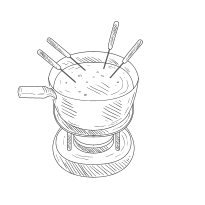When it comes to fondue, the right equipment can make all the difference. One decision you’ll need to make is whether to choose a stainless steel or ceramic fondue pot. Both materials have their pros and cons, so it’s important to understand them before making your decision.
Stainless steel fondue pots are known for their durability and even heating. They are easy to clean and can handle high temperatures, making them suitable for cheese, meat, and chocolate fondues. Stainless steel is also a non-reactive material, meaning it won’t leach any harmful chemicals into your food. Additionally, stainless steel fondue pots are typically cheaper than ceramic ones.
One con of stainless steel fondue pots is that they can be prone to discoloration and scratches over time. You’ll want to be careful not to scrub them too vigorously when cleaning or use abrasive cleaners, as this can damage the surface and affect their appearance. Stainless steel also isn’t the best insulator, so you may need to use a burner or reheat your fondue to keep it warm.
Ceramic fondue pots, on the other hand, are known for their beauty and ability to retain heat. They come in a variety of colors and designs, making them a great addition to any table setting. Ceramic pots are also better at insulating than stainless steel, meaning you won’t need a burner or constant reheating.
However, ceramic fondue pots are more delicate than their stainless steel counterparts. They can crack or break if dropped or exposed to sudden changes in temperature. Ceramic is also a porous material, which means it’s more likely to absorb flavors and odors from previous fondues.
In conclusion, both stainless steel and ceramic fondue pots have their pros and cons. Stainless steel is durable, easy to clean, and affordable, but can discolor and scratch over time. Ceramic is beautiful, retains heat well, and adds a unique touch to your table setting, but can be delicate and absorb flavors from previous fondues. Ultimately, the decision comes down to personal preference and specific needs.
